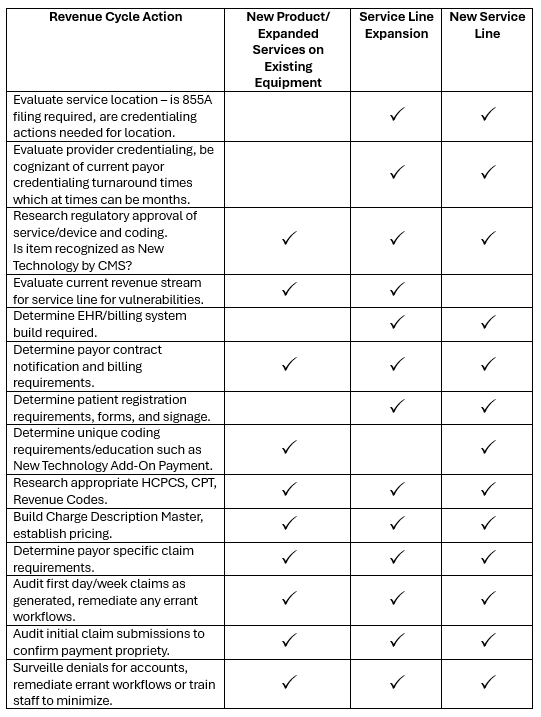Engage your Revenue Cycle Team Early
Are you engaging your Revenue Cycle Team when you need to? Does Revenue Cycle sit at the table with your Value Analysis Team? Is Revenue Cycle in the loop for approvals regarding new technology, capital, and strategic service line decisions?
CFO’s, Finance and Procurement Leaders must facilitate Revenue Cycle’s evaluation during service planning. Revenue Cycle participation prior to commencement of a new service allows regulatory research, proper credentialing, consideration of system build requirements, identification of authorization or other payor requirements, confirmation of specific claim build expectations, and claim/denial auditing for prompt remediation of issues. Tackling these steps prior to the start of a service allows cashflow for new services to materialize more quickly, speeding achievement of the expected return on investment (ROI).
New Products/New Equipment with Expanded Services
There are many scenarios when a new product or a new technology brings the potential for additional revenue. A provider or vendor may present a new technology, procedure or device designed to enhance patient outcomes. Alternatively, your organization might replace a medical device that brings medical advances for your patients. Once the item passes the clinical evaluation, it is crucial to involve the Revenue Cycle team into the conversation before the decision is final.
The Revenue Cycle team will review regulations and coding resources to ensure proper charging, coding, and billing. While vendors often provide suggested coding for new items, best practice recommends confirming this information – trust but verify. Health Information Management (HIM) Coders will review the suggested codes and related diagnoses. If the item is recognized by CMS as qualifying for a New Technology Add-On payment, coders will need to be aware of the appropriate ICD-10-PCS code to utilize. Charge Description Master (CDM) evaluation will ensure compliance with regulations and support necessary system updates. Considering the payor mix for the service, Revenue Cycle can reach out to payor representatives or consult their websites to determine coverage, authorization requirements, site-of-service restrictions, and specific claim elements to secure payment.
Service Expansion
Planning for service line expansion provides an opportunity for a comprehensive review of revenue. The Revenue Cycle Team can perform a walk-through of sample accounts to assure charges, coding and claims are moving through the revenue cycle with accuracy and efficiency, highlighting opportunities for improvement. Comparison of actual payments to expected payments for each payor will confirm payment propriety or identify opportunities for improved contract adherence.
Expanding a service to an off-campus location may require regulatory approval, updates to the CMS Form 855, and payor contract revisions. A credentialing review is recommended for both the facility and, if applicable, the providers involved. If new providers will be employed, it is essential to allow adequate lead time for the payor credentialing process - this can take several months.
Establishing a new revenue center will likely require system build efforts to set up the department, location, and Charge Description Master. Registration processes must ensure that all necessary registration documents are prepared for the location and that signage meets regulatory standards.
Once operational, Revenue Cycle should monitor accounts for the initial days of service to track their progression through to claims generation, adjusting workflows as needed if errors arise. Audits of adjudicated claims are recommended to confirm system accuracy and functionality. Monitoring denials for the location helps identify workflow issues early and identifies staff training required.
New Service Lines
Bringing a new service line to your community improves access to care for your patients. Involving Revenue Cycle in planning from the outset is critical. Specific system build may be required in the EHR and billing support systems. Facility and provider credentialing steps must be prioritized - allow several months to complete these actions. Revenue Cycle should research the regulations and billing criteria for the service line. Coders and billers may require targeted education on the nuances and success factors unique to the new offering. Notification to payors about the new service line, as required under contract provisions, will need to occur. Revenue Cycle must identify any payor-specific authorization or claim requirements for the service.
The earlier recommendations for registration, billing and denial actions for new locations also apply to a new service line.
The chart below summarizes the recommended actions discussed.

Expanding services and bringing new technology to advance patient outcomes and access is an essential component of supporting patients and community. Engaging Revenue Cycle during evaluation and planning is instrumental in achieving accurate and timely revenue flow, enabling the organization to meet the expected ROI and positioning the organization for long-term financial health and sustainability.
Every organization and situation is different. If you need tailored support in applying these revenue cycle strategies, we can help.
For more information, please contact:
Kathy D. Hoffman, CPA| | 518-229-4347





